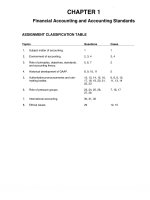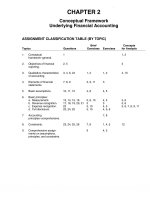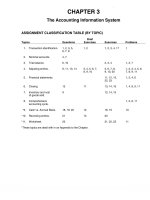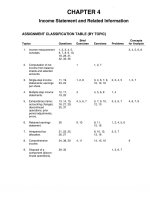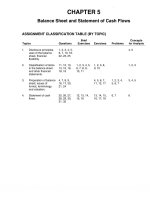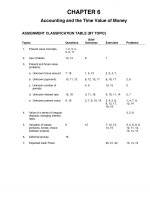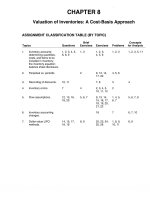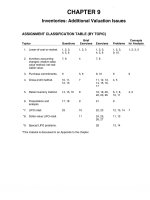Solution manual intermediate accounting 13e kieso ch18
Bạn đang xem bản rút gọn của tài liệu. Xem và tải ngay bản đầy đủ của tài liệu tại đây (546.79 KB, 94 trang )
To download more slides, ebook, solutions and test bank, visit
CHAPTER 18
Revenue Recognition
ASSIGNMENT CLASSIFICATION TABLE (BY TOPIC)
Brief
Exercises
Exercises
Problems
*1. Realization and recognition; 1, 2, 3, 4,
sales transactions; high
5, 6, 22
rates of return.
1
1, 2, 3
1
1, 2, 3, 4, 5,
7, 8, 9
*2. Long-term contracts.
7, 8, 9, 10,
11, 12, 22
2, 3, 4,
5, 6
4, 5, 6, 7,
8, 9, 10
1, 2, 3, 4,
5, 6, 7, 15,
16, 17
1, 2, 3, 6
*3. Installment sales.
13, 14, 16,
17, 18, 19,
20, 21, 22
7, 8, 9
11, 12, 13,
14, 15, 16
1, 8, 9, 10,
11, 12, 14
1, 2, 3
8
13, 17, 18
10, 11, 12,
13, 14
Topics
Questions
*4. Repossessions on
installment sales.
Concepts
for Analysis
*5. Cost-recovery method;
deposit method.
13, 14, 15,
23, 24
10
15, 16
8, 9
*6. Franchising.
22, 28, 29,
30, 31
11
19, 20
10
*7. Consignments.
22, 32
12
21
*This material is dealt with in an Appendix to the chapter.
Copyright © 2010 John Wiley & Sons, Inc.
Kieso, Intermediate Accounting, 13/e, Solutions Manual
(For Instructor Use Only)
18-1
To download more slides, ebook, solutions and test bank, visit
ASSIGNMENT CLASSIFICATION TABLE (BY LEARNING OBJECTIVE)
Learning Objectives
Brief
Exercises
Exercises
Problems
1.
Apply the revenue recognition principle.
1
1, 2, 3
2.
Describe accounting issues for revenue
recognition at point of sale.
1
1, 2, 3
1
3.
Apply the percentage-of-completion method
for long-term contracts.
2, 3
4, 5, 6, 7, 8, 9
1, 2, 3, 4, 5,
6, 7, 16, 17
4.
Apply the completed-contract method
for long-term contracts.
4, 5
4, 8, 9, 10
1, 2, 3, 5, 6, 7,
15, 16, 17
5.
Identify the proper accounting for losses
on long-term contracts.
6
10
5, 6, 7, 15
6.
Describe the installment-sales method
of accounting.
7, 8, 9
11, 12, 13, 14,
15, 16, 17, 18
1, 8, 9, 10, 11,
12, 13, 14
7.
Explain the cost-recovery method
of accounting.
10
15, 16
Explain revenue recognition for franchises
and consignment sales.
11, 12
19, 20, 21
*8.
18-2
Copyright © 2010 John Wiley & Sons, Inc.
Kieso, Intermediate Accounting, 13/e, Solutions Manual
(For Instructor Use Only)
To download more slides, ebook, solutions and test bank, visit
ASSIGNMENT CHARACTERISTICS TABLE
Item
E18-1
E18-2
E18-3
E18-4
E18-5
E18-6
E18-7
E18-8
E18-9
E18-10
E18-11
E18-12
E18-13
E18-14
E18-15
E18-16
*E18-17
*E18-18
*E18-19
*E18-20
*E18-21
P18-1
P18-2
P18-3
P18-4
P18-5
P18-6
P18-7
P18-8
P18-9
P18-10
P18-11
P18-12
P18-13
P18-14
P18-15
Level of
Time
Difficulty (minutes)
Description
Revenue recognition on book sales with high returns.
Sales recorded both gross and net.
Revenue recognition on marina sales with discounts.
Recognition of profit on long-term contracts.
Analysis of percentage-of-completion financial statements.
Gross profit on uncompleted contract.
Recognition of profit, percentage-of-completion.
Recognition of revenue on long-term contract and entries.
Recognition of profit and balance sheet amounts for longterm contracts.
Long-term contract reporting.
Installment-sales method calculations, entries.
Analysis of installment-sales accounts.
Gross profit calculations and repossessed merchandise.
Interest revenue from installment sale.
Installment-sales method and cost-recovery method.
Installment-sales method and cost-recovery method.
Installment-sales—default and repossession.
Installment-sales—default and repossession.
Franchise entries.
Franchise fee, initial down payment.
Consignment computations.
Comprehensive three-part revenue recognition.
Recognition of profit on long-term contract.
Recognition of profit and entries on long-term contract.
Recognition of profit and balance sheet presentation,
percentage-of-completion.
Completed contract and percentage-of-completion
with interim loss.
Long-term contract with interim loss.
Long-term contract with an overall loss.
Installment-sales computations and entries.
Installment-sales income statements.
Installment-sales computations and entries.
Installment-sales entries.
Installment-sales computations and entries—periodic
inventory.
Installment repossession entries.
Installment-sales computations and schedules.
Completed-contract method.
Copyright © 2010 John Wiley & Sons, Inc.
Kieso, Intermediate Accounting, 13/e, Solutions Manual
Moderate
Simple
Moderate
Moderate
Moderate
Simple
Moderate
Moderate
Simple
15–20
15–20
10–15
20–25
10–15
10–12
25–30
15–20
15–25
Simple
Simple
Moderate
Moderate
Simple
Simple
Simple
Simple
Simple
Simple
Simple
Simple
15–25
15–20
15–20
15–20
10–15
10–15
15–20
10–15
15–20
14–18
12–16
15–20
Moderate
Simple
Moderate
Moderate
30–45
20–25
25–35
20–30
Moderate
25–30
Moderate
Moderate
Moderate
Moderate
Complex
Simple
Complex
20–25
20–25
25–30
30–35
30–40
20–25
40–50
Moderate
Complex
Moderate
20–25
50–60
20–30
(For Instructor Use Only)
18-3
To download more slides, ebook, solutions and test bank, visit
ASSIGNMENT CHARACTERISTICS TABLE (Continued)
Description
Level of
Time
Difficulty (minutes)
P18-16
P18-17
Revenue recognition methods—comparison.
Comprehensive problem—long-term contracts.
Complex
Complex
40–50
50–60
CA18-1
CA18-2
CA18-3
CA18-4
CA18-5
CA18-6
CA18-7
CA18-8
CA18-9
*CA18-10
Revenue recognition—alternative methods.
Recognition of revenue—theory.
Recognition of revenue—theory.
Recognition of revenue—bonus dollars.
Recognition of revenue from subscriptions.
Long-term contract—percentage-of-completion.
Revenue recognition—real estate development.
Revenue recognition, ethics
Revenue recognition—membership fees, ethics
Franchise revenue.
Moderate
Moderate
Moderate
Moderate
Complex
Moderate
Moderate
Moderate
Moderate
Moderate
20–30
35–45
25–30
30–35
35–45
20–25
30–40
25–30
20–25
35–45
Item
18-4
Copyright © 2010 John Wiley & Sons, Inc.
Kieso, Intermediate Accounting, 13/e, Solutions Manual
(For Instructor Use Only)
To download more slides, ebook, solutions and test bank, visit
SOLUTIONS TO CODIFICATION EXERCISES
CE18-1
Master Glossary
(a)
Under the cost-recovery method, no profit is recognized until cash payments by the buyer,
including principal and interest on debt due to the seller and on existing debt assumed by the
buyer, exceed the seller’s cost of the property sold.
(b)
A method of recognizing profit for time-sharing transactions under which the amount of revenue
recognized (based on the sales value) at the time a sale is recognized is measured by the relationship of costs already incurred to the total of costs already incurred and future costs expected
to be incurred.
(c)
Under the deposit method, the seller does not recognize any profit, does not record notes
receivable, continues to report in its financial statements the property and the related existing
debt even if it has been assumed by the buyer, and discloses that those items are subject to a
sales contract.
(d)
The installment-sales method apportions each cash receipt and principal payment by the buyer
on debt assumed between cost recovered and profit. The apportionment is in the same ratio as
total cost and total profit bear to the sales value.
CE18-2
According to FASB ASC 605-10-25-3 (Revenue Recognition—Recognition):
Revenue should ordinarily be accounted for at the time a transaction is completed, with appropriate provision for uncollectible accounts. Revenue and gains generally are not recognized until being realized or
realizable and until earned. Accordingly, unless the circumstances are such that the collection of the sale
price is not reasonably assured, the installment-sales method of recognizing revenue is not acceptable.
CE18-3
According to FASB ASC 910-605-50-2 (Contractors—Revenue Recognition—Disclosure):
If the completed-contract method is used, the reason for selecting that method shall be indicated, for
example, either of the following:
(a)
Numerous short-term contracts for which financial position and results of operations reported on
the completed-contract basis would not vary materially from those resulting from use of the
percentage-of-completion method.
(b)
Inherent hazards or undependable estimates that cause forecasts to be doubtful.
Copyright © 2010 John Wiley & Sons, Inc.
Kieso, Intermediate Accounting, 13/e, Solutions Manual
(For Instructor Use Only)
18-5
To download more slides, ebook, solutions and test bank, visit
CE18-4
According to FASB ASC 605-10-25-4 (Revenue Recognition—Recognition):
There may be exceptional cases where receivables are collectible over an extended period of time and,
because of the terms of the transactions or other conditions, there is no reasonable basis for estimating
the degree of collectibility. When such circumstances exist, and as long as they exist, either the installmentsales method or the cost recovery method of accounting may be used. As defined in paragraph 360-2055-7 through 55-9, the installment-sales method apportions collections received between cost recovered and profit. The apportionment is in the same ratio as total cost and total profit bear to the sales value.
Under the cost recovery method, equal amounts of revenue and expense are recognized as collections
are made until all costs have been recovered, postponing any recognition of profit until that time.
18-6
Copyright © 2010 John Wiley & Sons, Inc.
Kieso, Intermediate Accounting, 13/e, Solutions Manual
(For Instructor Use Only)
To download more slides, ebook, solutions and test bank, visit
ANSWERS TO QUESTIONS
1.
A series of highly publicized cases of companies recognizing revenue prematurely has caused
the SEC to increase its enforcement actions in this area. In some of these cases, significant
adjustments to previously issued financial statements were made. Some of these cases involved
contingent sales where side agreements were in place or high rates of return occurred. In addition,
in some cases, unfinished product was shipped to customers and counted as revenues or
unauthorized product was shipped to customers and counted as revenues.
2.
Revenue is conventionally recognized at the date of sale. For revenue to be recognized at the
date of sale, (1) the amount of the revenue should be reasonably measurable—that is, the
collectibility of the sales price is reasonably assured or the amount uncollectible can be estimated
reasonably (realized or realizable)—and (2) the earnings process is complete or virtually
complete—that is, the seller is not obligated to perform significant activities after the sale to earn
the revenue.
3.
Revenues are recognized generally as follows:
(a) Revenue from selling products—date of delivery to customers.
(b) Revenue from services rendered—when the services have been performed and are billable.
(c) Revenue from permitting others to use enterprise assets—as time passes or as the assets
are used.
(d) Revenue from disposing of assets other than products—at the date of sale.
4.
Types of sales transactions: (1) Cash sale. (2) Credit sale. (3) C.O.D. sale. (4) Will-call or layaway
sale. (5) Sale in advance of delivery (long-term construction). (6) Branch sale. (7) Intercompany
sale. (8) Franchise sale. (9) Installment sale.
The student should identify for each type of sale a form of business which typically engages in that
type of sale. Many of these sales transactions are not mentioned in this chapter, so the student
will probably not identify all these transactions.
5.
The three alternatives available to a seller that is exposed to risks of ownership due to a return of
the product are:
(1) Not recording the sale until all return privileges have expired.
(2) Recording the sale, but reducing sales by an estimate of future returns.
(3) Recording the sale and accounting for the returns as they occur in the future.
6.
GAAP requires that such sales transactions not be recognized as current revenue unless all of
the following six conditions are met:
(1) The seller’s price to the buyer is substantially fixed or determinable at the date of sale.
(2) The buyer has paid the seller, or the buyer is obligated to pay the seller, and the obligation is
not contingent on resale of the product.
(3) The buyer’s obligation to the seller would not be changed in the event of theft or physical
destruction or damage of the product.
(4) The buyer acquiring the product for resale has economic substance apart from that provided
by the seller.
(5) The seller does not have significant obligations for future performance to directly bring about
resale of the product by the buyer.
(6) The seller can reasonably estimate the amount of future returns.
7.
The two basic methods of accounting for long-term construction contracts are: (1) the percentageof-completion method and (2) the completed-contract method.
Copyright © 2010 John Wiley & Sons, Inc.
Kieso, Intermediate Accounting, 13/e, Solutions Manual
(For Instructor Use Only)
18-7
To download more slides, ebook, solutions and test bank, visit
Questions Chapter 18 (Continued)
The percentage-of-completion method is preferable when estimates of costs to complete and
extent of progress toward completion of long-term contracts are reasonably dependable. The
percentage-of-completion method should be used in circumstances when reasonably dependable
estimates can be made and:
(1) The contract clearly specifies the enforceable rights regarding goods or services to be
provided and received by the parties, the consideration to be exchanged, and the manner
and terms of settlement.
(2) The buyer can be expected to satisfy all obligations under the contract.
(3) The contractor can be expected to perform the contractual obligation.
The completed-contract method is preferable when the lack of dependable estimates or inherent
hazards cause forecasts to be doubtful.
8.
Costs Incurred
X Total Revenue = Revenue Recognized
Total Estimated Cost
$8 million
$50 million
X $60,000,000 = $9,600,000
Revenue Recognized – Actual Cost Incurred = Gross Profit Recognized
$9,600,000 – $8,000,000 = $1,600,000
9.
Under the percentage-of-completion method, income is reported to reflect more accurately the
production effort. Income is recognized periodically on the basis of the percentage of the job
completed rather than only when the entire job is completed. The principal disadvantage of the
completed-contract method is that it may lead to distortion of earnings because no attempt is
made to reflect current performance when the period of the contract extends into more than one
accounting period.
10.
The methods used to determine the extent of progress toward completion are the cost-to-cost
method and units-of-delivery method. Costs incurred and labor hours worked are examples of
input measures, while tons produced, stories of a building completed, and miles of highway
completed are examples of output measures.
11.
The two types of losses that can become evident in accounting for long-term contracts are:
(1) A current period loss involved in a contract that, upon completion, is expected to produce
a profit.
(2) A loss related to an unprofitable contract.
The first type of loss is actually an adjustment in the current period of gross profit recognized on
the contract in prior periods. It arises when, during construction, there is a significant increase in the
estimated total contract costs but the increase does not eliminate all profit on the contract. Under
the percentage-of-completion method, the estimated cost increase necessitates a current period
adjustment of previously recognized gross profit; the adjustment results in recording a current
period loss. No adjustment is necessary under the completed-contract method because gross
profit is only recognized upon completion of the contract.
Cost estimates at the end of the current period may indicate that a loss will result upon completion of the entire contract. Under both methods, the entire loss must be recognized in the
current period.
18-8
Copyright © 2010 John Wiley & Sons, Inc.
Kieso, Intermediate Accounting, 13/e, Solutions Manual
(For Instructor Use Only)
To download more slides, ebook, solutions and test bank, visit
Questions Chapter 18 (Continued)
12.
The dollar amount of difference between the Construction in Process and the Billings on Construction in Process accounts is reported in the balance sheet as a current asset if a debit and as
a current liability if a credit. When the balance in Construction in Process exceeds the billings,
this excess is reported as a current asset, “Costs and Recognized Profit in Excess of Billings.”
When the billings exceed the Construction in Process balance, the excess is reported as a
current liability, “Billings in Excess of Costs and Recognized Profit.”
13.
Under the installment-sales method, income recognition is deferred until the period of cash
collection. At the end of each year, the appropriate gross profit rate is applied to the cash
collections from each year’s sales to determine the realized gross profit. Under the cost-recovery
method, no income is recognized until cash payments by the buyer exceed the seller’s cost of the
inventory sold. After all costs have been recovered, all additional cash collections are included in
income.
14.
The two methods generally employed to account for cash received when cash collection of the sales
price is not reasonably assured are: (1) the cost-recovery method and (2) the installment-sales method.
The cost-recovery method is used when the seller has performed on the contract, but cash collection
is highly uncertain. Equal amounts of revenue and expense are recognized as collections are
made until all costs have been recovered; thereafter, any cash received is included in income.
The installment-sales method is used when there is no reasonable basis for estimating the
degree of collectibility. Revenue is recognized only as cash is collected. Unlike the cost-recovery
method, a percentage of each cash collection is recorded as realized income.
15.
The deposit method postpones recognizing a sale by treating the cash received from a buyer as
a deposit. The deposit method is applied when the seller receives cash but has not performed
under the contract and has no claim against the purchaser.
16.
An installment sale is a special type of credit arrangement which provides for payment in periodic
installments over a predetermined period of time and results from the sale of real estate,
merchandise, or other personal property. In the ordinary credit sale, the collection interval is short
(30–90 days) and title passes unconditionally to the buyer concurrently with the completion of the
sale (delivery). In contrast, in an installment sale the cash down payment at the date of sale is
followed by payments over a longer period of time (six months to several years), and in many
states the transfer of title remains conditional until the debt is fully discharged.
17.
Under the installment-sales method of accounting, emphasis is placed on collection rather than
sale. Because of the unique characteristics of installment sales, particularly the longer collection
period and higher risk of loss through bad debts, gross profit is considered to be realized in
proportion to the collections on the installment accounts. Thus, under the installment-sales
method, each collection on an installment account is regarded as a partial recovery of cost and a
partial realization of gross profit (margin) in the same proportion that these two elements are
present in the original selling price. Under the installment-sales method, accounts receivable,
sales, and cost of sales are accounted for separately for regular and installment sales.
Installment receivables are identified by year of sale so that the gross profit can be recognized in
each period in proportion to the original year of sales’ gross profit rate applied to current collections
on installment accounts receivable.
18.
In the application of the installment-sales method, most companies record operating expenses
without regard to the fact that some portion of the year’s gross profit is to be deferred revenue.
This is often justified on the basis that: (1) these expenses do not follow sales as closely as does
the cost of goods sold, and (2) accurate apportionment among periods would be so difficult as
not to be justified by the benefits gained.
Copyright © 2010 John Wiley & Sons, Inc.
Kieso, Intermediate Accounting, 13/e, Solutions Manual
(For Instructor Use Only)
18-9
To download more slides, ebook, solutions and test bank, visit
Questions Chapter 18 (Continued)
19.
Year
2010
2011
2012
Cash
Collected
X
*Gross Profit
Percentage
$ 80,000
320,000
100,000
$500,000
34%
34%
34%
=
Gross Profit
Recognized
$ 27,200
108,800
34,000
$170,000
*[($500,000 – $330,000) ÷ $500,000]
20.
When interest is involved in installment sales, it should be separately accounted for as interest
revenue distinct from the gross profit recognized on the installment-sales collections during the
period. The amount of interest recognized each period is dependent upon the installment payment
schedule.
21.
With respect to the income statement, the degree of detail to be reported frequently will vary,
depending upon the magnitude of installment-sales revenues in relation to total sales. If installment sales are relatively insignificant in amount, they may be merged with regular sales with no
separate designation. In this case the realized gross profit on installment sales normally is reported
on the income statement as a separate item immediately below gross profit.
Alternatively, should installment sales represent a material amount of the total revenue of the
business enterprise, additional detail may be required for a full and informative disclosure. In
such cases it might be desirable to report on the income statement three columns as follows:
(1) Total, (2) Regular Sales, and (3) Installment Sales. Obviously, many variations are possible
and should be used to meet the necessities of information and full disclosure.
22.
(a) Income (gross profit) on certain installment sales may be recognized on a basis of:
Gross Profit
Selling Price
X Collections.
In some cases where collection is uncertain, the cost-recovery method might be employed.
(b) The income on sales for future delivery is not recognized until title has passed to the buyer.
(c) When the consignee returns an “account sales” reporting the sale of the merchandise.
(d) Under the percentage-of-completion method:
Cost to Date
Estimated Total Cost
(e)
23.
X Estimated Gross Profit ,
or when the contract is completed.
During the periods in which the publications are issued.
Under the cost-recovery method, revenue is recognized (along with the relevant cost of goods sold)
in the period of the sale. However, the gross profit is deferred and is not recognized in the income
statement until cash payments received from the buyer exceed the cost of the merchandise sold.
In those periods in which the cash payments exceed the costs, the excess receipts (representing
gross profits deferred) are reported as a separate item of revenue.
18-10
Copyright © 2010 John Wiley & Sons, Inc.
Kieso, Intermediate Accounting, 13/e, Solutions Manual
(For Instructor Use Only)
To download more slides, ebook, solutions and test bank, visit
Questions Chapter 18 (Continued)
*24.
Under the deposit method, revenue is not recognized. The deposit method treats cash advances
and other payments received as refundable deposits. The sales transaction is not considered
complete and recognizable. Only after sufficient risks and rewards of ownership have been
transferred and the sale is considered complete is one of the other revenue recognition methods
discussed in the chapter applied to the sale transaction.
The major difference is that in the installment-sales and cost-recovery methods, it is assumed
that the seller has performed on the contract but cash collection is highly uncertain. Under the
deposit method, the seller has not performed and no legitimate claim exists.
*25.
The general concepts and principles used for revenue recognition are similar between U.S.
GAAP and iGAAP. When they differ is in the detail. U.S. GAAP provides specific guidance
related to revenue recognition in many different industries. That is not the case for iGAAP. Also
the SEC has issued broad and specific guidance for public companies in the United States
related to revenue recognition. Again the IASB does not have a regulatory body that provides
additional guidance.
*26.
If revenues and costs are difficult to estimate, then companies recognize revenue only to the extent
of the cost incurred—a zero-profit approach.
*27.
In the first year, the company should report revenues up to what costs are incurred. Assuming
that the costs incurred in the first year are $40 million, the company should report revenue of
$40 million. In this case a zero-profit is recognized.
*28.
It is improper to recognize the entire franchise fee as revenue at the date of sale when many of
the services of the franchisor are yet to be performed and/or uncertainty exists regarding collection
of the entire fee.
*29.
In a franchise sale, the franchisor may record initial franchise fees as revenue only when the
franchisor makes “substantial performance” of the services it is obligated to perform. Substantial
performance occurs when the franchisor has no remaining obligation to refund any cash received
or excuse any nonpayment of a note and has performed all the initial services required under the
contract.
*30.
Continuing franchise fees should be reported as revenue when they are earned and receivable
from the franchisee, unless a portion of them have been designated for a particular purpose. In
that case, the designated amount should be recorded as revenue, with the costs charged to an
expense account. Continuing product sales would be accounted for in the same manner as
would any other product sales.
*31.
(a)
If it is likely that the franchisor will exercise an option to purchase the franchised outlet, the
initial franchise fee should not be recorded as a revenue but as a deferred credit. When
the option is exercised, the deferred amount would reduce the franchisor’s investment in
the outlet.
(b)
When the franchise agreement allows the franchisee to purchase equipment and supplies
at bargain prices from the franchisor, a portion of the initial franchise fee should be deferred.
The deferred portion would be accounted for as an adjustment of the selling price when the
franchisee subsequently purchases the equipment and supplies.
Copyright © 2010 John Wiley & Sons, Inc.
Kieso, Intermediate Accounting, 13/e, Solutions Manual
(For Instructor Use Only)
18-11
To download more slides, ebook, solutions and test bank, visit
Questions Chapter 18 (Continued)
*32.
A sale on consignment is the shipment of merchandise from a manufacturer (or wholesaler) to
a dealer (or retailer) with title to the goods and the risk of sale being retained by the manufacturer
who becomes the consignor. The consignee (dealer) is expected to exercise due diligence in
caring for the merchandise and the dealer has full right to return the merchandise. The consignee
receives a commission upon the sale and remits the balance of the cash collected to the consignor.
The consignor recognizes a sale and the related revenue upon notification of sale from the
consignee and receipt of the cash. The consigned goods are carried in the consignor’s inventory,
not the consignee’s, until sold.
18-12
Copyright © 2010 John Wiley & Sons, Inc.
Kieso, Intermediate Accounting, 13/e, Solutions Manual
(For Instructor Use Only)
To download more slides, ebook, solutions and test bank, visit
SOLUTIONS TO BRIEF EXERCISES
BRIEF EXERCISE 18-1
(a) Sales Returns and Allowances ............................
Accounts Receivable......................................
78,000
(b) Sales Returns and Allowances ............................
Allowance for Estimated Sales
Returns and Allowances............................
[(15% X $700,000) – $78,000]
27,000
78,000
27,000
BRIEF EXERCISE 18-2
Construction in Process .................................................
Materials, Cash, Payables, etc. ............................
1,700,000
Accounts Receivable........................................................
Billings on Construction in Process ..................
1,200,000
Cash .......................................................................................
Accounts Receivable...............................................
960,000
Construction in Process .................................................
[($1,700,000 ÷ 5,000,000) X $2,000,000]
Construction Expenses ...................................................
Revenue from Long-Term Contracts..................
($7,000,000,000 X 34%)
680,000
1,700,000
1,200,000
960,000
1,700,000
2,380,000
BRIEF EXERCISE 18-3
Current Assets
Accounts Receivable...............................................
Inventories
Construction in process................................
Less: Billings ...................................................
Costs and recognized profit in
excess of billings .................................
Copyright © 2010 John Wiley & Sons, Inc.
$ 240,000
$2,450,000
1,400,000
Kieso, Intermediate Accounting, 13/e, Solutions Manual
1,050,000
(For Instructor Use Only)
18-13
To download more slides, ebook, solutions and test bank, visit
BRIEF EXERCISE 18-4
Construction in Process......................................................
Materials, Cash, Payables, etc..................................
1,700,000
Accounts Receivable ............................................................
Billings on Construction in Process.......................
1,200,000
Cash............................................................................................
Accounts Receivable ...................................................
960,000
1,700,000
1,200,000
960,000
BRIEF EXERCISE 18-5
Current Assets
Accounts Receivable ...................................................
Inventories
Construction in process .................................... $1,715,000
Less: Billings........................................................ 1,000,000
Costs and recognized profit in excess
of billings ...............................................................
$240,000
715,000
BRIEF EXERCISE 18-6
(a) Construction Expenses...............................................
Construction in Process (Loss) ......................
Revenue from Long-Term Contracts .............
(b) Loss from Long-Term Contracts..............................
Construction in Process (Loss) ......................
278,000
20,000*
258,000
20,000*
20,000
*[$420,000 – ($278,000 + $162,000)]
BRIEF EXERCISE 18-7
Installment Accounts Receivable, 2010..........................
Installment Sales ...........................................................
150,000
Cash............................................................................................
Installment Accounts Receivable, 2010.................
54,000
Cost of Installment Sales........................................................
Inventory .............................................................................
102,000
18-14
Copyright © 2010 John Wiley & Sons, Inc.
150,000
54,000
Kieso, Intermediate Accounting, 13/e, Solutions Manual
102,000
(For Instructor Use Only)
To download more slides, ebook, solutions and test bank, visit
BRIEF EXERCISE 18-7 (Continued)
Installment Sales .........................................................................
Cost of Installment Sales .................................................
Deferred Gross Profit, 2010.............................................
150,000
Deferred Gross Profit, 2010......................................................
Realized Gross Profit on Installment Sales
(32% X $54,000)..............................................................
17,280
102,000
48,000
17,280
BRIEF EXERCISE 18-8
Repossessed Merchandise .......................................................
Loss on Repossession ...............................................................
Deferred Gross Profit ($520 X 40%)........................................
Installment Accounts Receivable...................................
275
37*
208
520
*[$275 – ($520 – $208)]
BRIEF EXERCISE 18-9
Current Assets
Installment accounts receivable due in 2011 .............
Installment accounts receivable due in 2012 .............
Current Liabilities
Deferred gross profit ($23,400 + $41,800)....................
$ 65,000
110,000
$175,000
$ 65,200
BRIEF EXERCISE 18-10
2010
2011
2012
$0
$2,000 ($15,000 – $13,000)
$5,000
Copyright © 2010 John Wiley & Sons, Inc.
Kieso, Intermediate Accounting, 13/e, Solutions Manual
(For Instructor Use Only)
18-15
To download more slides, ebook, solutions and test bank, visit
*BRIEF EXERCISE 18-11
Cash..................................................................................................
Notes Receivable .........................................................................
Discount on Notes Receivable .......................................
Unearned Franchise Fees ($25,000 + $41,402)..........
25,000
50,000
8,598
66,402
*BRIEF EXERCISE 18-12
Cash..................................................................................................
Advertising Expense...................................................................
Commission Expense.................................................................
Revenue from Consignment Sales................................
18,850*
500
2,150
21,500
*[$21,500 – $500 – ($21,500 X 10%)]
Cost of Goods Sold .....................................................................
Inventory on Consignment ..............................................
[60% X ($20,000 + $2,000)]
18-16
Copyright © 2010 John Wiley & Sons, Inc.
13,200
Kieso, Intermediate Accounting, 13/e, Solutions Manual
13,200
(For Instructor Use Only)
To download more slides, ebook, solutions and test bank, visit
SOLUTIONS TO EXERCISES
EXERCISE 18-1 (15–20 minutes)
(a) Uddin could recognize revenue at the point of sale based upon the time
of shipment because the books are sold f.o.b. shipping point. Because
of the return policy one might argue in favor of the cash collection basis.
Because the returns can be estimated, one could argue for shipping
point less estimated returns.
(b) Based on the available information and lack of any information indicating that any of the criteria in GAAP were not met, the correct treatment
is to report revenue at the time of shipment as the gross amount less
the 12% normal return factor. This is supported by the legal test of
transfer of title and the criteria in GAAP. One could be very conservative
and use the 30% maximum return allowance.
(c) Accounts Receivable.............................................
Sales Revenue—Texts .................................
15,000,000
Sales Returns* ($15,000,000 X 12%).................
Allowance for Sales Returns......................
1,800,000
(d) Sales Returns* .........................................................
Allowance for Sales Returns ..............................
Accounts Receivable....................................
200,000
1,800,000
Cash ............................................................................
Accounts Receivable....................................
13,000,000
15,000,000
1,800,000
2,000,000
13,000,000
*A debit to Sales Revenue—Texts or Sales Returns could be made here.
EXERCISE 18-2 (15–20 minutes)
(a) 1. 6/3
Accounts Receivable—Ann Mount......
Sales ...................................................
Copyright © 2010 John Wiley & Sons, Inc.
Kieso, Intermediate Accounting, 13/e, Solutions Manual
8,000
8,000
(For Instructor Use Only)
18-17
To download more slides, ebook, solutions and test bank, visit
EXERCISE 18-2 (Continued)
6/5
6/7
6/12
2.
6/3
6/5
6/7
6/12
(b)
8/5
Sales Returns and Allowances.......................
Accounts Receivable—Ann Mount ......
600
Transportation-Out .............................................
Cash................................................................
24
Cash.........................................................................
Sales Discounts (2% X $7,400) .......................
Accounts Receivable—Ann Mount ......
7,252
148
Accounts Receivable—Ann Mount ...............
Sales [$8,000 – (2% X $8,000)] ...............
7,840
Sales Returns and Allowances.......................
Accounts Receivable—Ann Mount
[$600 – (2% x $600)] .............................
588
Transportation-Out .............................................
Cash................................................................
24
Cash.........................................................................
Accounts Receivable—Ann Mount ......
7,252
Cash.........................................................................
Accounts Receivable—Ann Mount ......
Sales Discounts Forfeited
(2% X $7,400) ............................................
7,400
600
24
7,400
7,840
588
24
7,252
7,252
148
EXERCISE 18-3 (10–15 minutes)
(a) Cash (2010 slips) (300 X $800).............................................. 240,000
Dock Rent Revenue .........................................................
240,000
Cash (2011 slips) [200 X $800 X (1.00 – .05)].................... 152,000
Unearned Revenue (current) ........................................
152,000
Cash (2012 slips) [60 X $800 X (1.00 – .20)]......................
Unearned Revenue (noncurrent).................................
18-18
Copyright © 2010 John Wiley & Sons, Inc.
38,400
Kieso, Intermediate Accounting, 13/e, Solutions Manual
38,400
(For Instructor Use Only)
To download more slides, ebook, solutions and test bank, visit
EXERCISE 18-3 (Continued)
(b) The marina operator should recognize that advance rentals generated
$190,400 ($152,000 + $38,400) of cash in exchange for the marina’s
promise to deliver future services. In effect, this has reduced future
cash flow by accelerating payments from boat owners. Also, the price
of rental services has effectively been reduced. The current cash
bonanza does not reflect current earned income. The future costs of
operation must be covered, in part, from this accelerated cash inflow.
On a present value basis, the granting of these discounts seems
ill-advised unless interest rates were to skyrocket so that the interest
earned would offset the discounts provided.
EXERCISE 18-4 (20–25 minutes)
(a) Gross profit recognized in:
2010
Contract price
Costs:
Costs to date
Estimated
costs to
complete
Total estimated
profit
Percentage
completed to
date
Total gross profit
recognized
Less: Gross
profit recognized
in previous years
Gross profit
recognized in
current year
2011
$1,600,000
$400,000
600,000
2012
$1,600,000
$825,000
1,000,000
600,000
40%*
275,000
$1,600,000
$1,070,000
1,100,000
0
1,070,000
500,000
530,000
75%**
100%
240,000
375,000
530,000
0
240,000
375,000
$ 240,000
$ 135,000
$
155,000
**$400,000 ÷ $1,000,000
**$825,000 ÷ $1,100,000
Copyright © 2010 John Wiley & Sons, Inc.
Kieso, Intermediate Accounting, 13/e, Solutions Manual
(For Instructor Use Only)
18-19
To download more slides, ebook, solutions and test bank, visit
EXERCISE 18-4 (Continued)
(b) Construction in Process ($825,000 – $400,000).....
Materials, Cash, Payables, etc. .......................
425,000
Accounts Receivable ($900,000 – $300,000) ...........
Billings on Construction in Process.................
600,000
Cash ($810,000 – $270,000)...........................................
Accounts Receivable .............................................
540,000
Construction Expenses..................................................
Construction in Process ................................................
Revenue from Long-Term Contracts ................
425,000
135,000
425,000
600,000
540,000
560,000*
*$1,600,000 X (75% – 40%)
(c) Gross profit recognized in:
Gross profit
2010
$–0–
2011
$–0–
2012
$530,000*
*$1,600,000 – $1,070,000
EXERCISE 18-5 (10–15 minutes)
(a) Contract billings to date ................................................
Less: Accounts receivable 12/31/10 .........................
Portion of contract billings collected ........................
(b)
$61,500
18,000
$43,500
$19,500
= 30%
$65,000
(The ratio of gross profit to revenue recognized in 2010.)
$1,000,000 X .30 = $300,000
(The initial estimated total gross profit before tax on the contract.)
18-20
Copyright © 2010 John Wiley & Sons, Inc.
Kieso, Intermediate Accounting, 13/e, Solutions Manual
(For Instructor Use Only)
To download more slides, ebook, solutions and test bank, visit
EXERCISE 18-6 (10–12 minutes)
DOUGHERTY INC.
Computation of Gross Profit to be
Recognized on Uncompleted Contract
Year Ended December 31, 2010
Total contract price
Estimated contract cost at completion
($800,000 + $1,200,000) .........................................................
Fixed fee ..........................................................................................
Total..........................................................................................
$2,000,000
450,000
2,450,000
Total estimated cost ....................................................................
Gross profit.....................................................................................
Percentage of completion ($800,000 ÷ $2,000,000) ...........
Gross profit to be recognized ($450,000 X 40%) ................
2,000,000
450,000
40%
$ 180,000
EXERCISE 18-7 (25–30 minutes)
(a) 1.
Gross profit recognized in 2010:
Contract price ........................................................
Costs:
Costs to date .................................................
Estimated additional costs .......................
Total estimated profit ..........................................
Percentage completion to date
($280,000/$800,000) .........................................
Gross profit recognized in 2010.......................
Gross profit recognized in 2011:
Contract price ........................................................
Costs:
Costs to date .................................................
Estimated additional costs .......................
Total estimated profit ..........................................
Percentage completion to date
($600,000/$800,000) .........................................
Total gross profit recognized ...........................
Less: Gross profit recognized in 2010 .........
Gross profit recognized in 2011.......................
Copyright © 2010 John Wiley & Sons, Inc.
Kieso, Intermediate Accounting, 13/e, Solutions Manual
$1,200,000
$280,000
520,000
800,000
400,000
35%
$ 140,000
$1,200,000
$600,000
200,000
800,000
400,000
75%
300,000
140,000
$ 160,000
(For Instructor Use Only)
18-21
To download more slides, ebook, solutions and test bank, visit
EXERCISE 18-7 (Continued)
2.
Construction in Process ($600,000 – $280,000)..... 320,000
Materials, Cash, Payables, etc..........................
320,000
Accounts Receivable ($500,000 – $150,000) ......... 350,000
Billings on Construction in Process...............
350,000
Cash ($320,000 – $120,000)......................................... 200,000
Accounts Receivable ...........................................
200,000
Construction in Process .............................................. 160,000
Construction Expenses................................................ 320,000
Revenues from Long-Term Contracts............
480,000*
*$1,200,000 X [($600,000 – $280,000) ÷ $800,000]
(b) Income Statement (2011)—
Gross profit on long-term construction contract ............
Balance Sheet (12/31/11)—
Current assets:
Receivables—construction in process ......................
Inventories—construction in process totaling
$900,000** less billings of $500,000........................
$160,000
$180,000*
$400,000
**$180,000 = $500,000 – $320,000
**Total cost to date
2010 Gross profit
2011 Gross profit
$600,000
140,000
160,000
$900,000
EXERCISE 18-8 (15–20 minutes)
(a)
2010—
$640,000
X $2,200,000 = $880,000
$1,600,000
2011—$2,200,000 (contract price) minus $880,000 (revenue recognized
in 2010) = $1,320,000 (revenue recognized in 2011).
18-22
Copyright © 2010 John Wiley & Sons, Inc.
Kieso, Intermediate Accounting, 13/e, Solutions Manual
(For Instructor Use Only)
To download more slides, ebook, solutions and test bank, visit
EXERCISE 18-8 (Continued)
(b) All $2,200,000 of the contract price is recognized as revenue in 2011.
(c) Using the percentage-of-completion method, the following entries
would be made:
Construction in Process................................................
Materials, Cash, Payables, etc. ..........................
640,000
Accounts Receivable......................................................
Billings on Construction in Process ................
420,000
Cash .....................................................................................
Accounts Receivable.............................................
350,000
Construction in Process................................................
Construction Expenses .................................................
Revenue from Long-Term Contracts
[from (a)]................................................................
240,000*
640,000
640,000
420,000
350,000
880,000
*[$2,200,000 – ($640,000 + $960,000)] X ($640,000 ÷ $1,600,000)
(Using the completed-contract method, all the same entries are made
except for the last entry. No income is recognized until the contract is
completed.)
EXERCISE 18-9 (15–25 minutes)
(a) Computation of Gross Profit to Be Recognized under CompletedContract Method.
No computation necessary. No gross profit to be recognized prior to
completion of contract.
Computation of Billings on Uncompleted Contract in Excess of Related
Costs under Completed-Contract Method.
Construction costs incurred during the year......................
Partial billings on contract (25% X $6,000,000) ..................
Copyright © 2010 John Wiley & Sons, Inc.
Kieso, Intermediate Accounting, 13/e, Solutions Manual
$ 1,185,800
(1,500,000)
$ (314,200)
(For Instructor Use Only)
18-23
To download more slides, ebook, solutions and test bank, visit
EXERCISE 18-9 (Continued)
(b) Computation of Gross Profit to Be Recognized under Percentage-ofCompletion Method.
Total contract price .......................................................................
Total estimated cost ($1,185,800 + $4,204,200)....................
Estimated total gross profit from contract ............................
Percentage-of-completion ($1,185,800/$5,390,000) ............
Gross profit to be recognized during the year
($610,000 X 22%) .........................................................................
$6,000,000
5,390,000
610,000
22%
$ 134,200
Computation of Billings on Uncompleted Contract in Excess of Related
Costs and Recognized Profit under Percentage-of-Completion Method.
Construction costs incurred during the year .......................
Gross profit to be recognized during the year (above) .....
Total charged to construction-in-process ....................
Partial billings on contract (25% X $6,000,000)....................
$ 1,185,800
134,200
1,320,000
(1,500,000)
$ (180,000)
EXERCISE 18-10 (15–25 minutes)
BERSTLER CONSTRUCTION COMPANY
Partial Income Statement
Year Ended December 31, 2010
Revenue from long-term contracts (Project 3)..............................
Costs of construction (Project 3).......................................................
Gross profit ...............................................................................................
Loss on long-term contract (Project 1)* ..........................................
*Computation of loss (Project 1)
Contract costs through 12/31/10 .....................
Estimated costs to complete............................
Total estimated costs..........................................
Total contract price..............................................
Loss recognized in 2010 ....................................
18-24
Copyright © 2010 John Wiley & Sons, Inc.
$520,000
330,000
190,000
(20,000)
$450,000
130,000
580,000
560,000
$ (20,000)
Kieso, Intermediate Accounting, 13/e, Solutions Manual
(For Instructor Use Only)
To download more slides, ebook, solutions and test bank, visit
EXERCISE 18-10 (Continued)
BERSTLER CONSTRUCTION COMPANY
Partial Balance Sheet
December 31, 2010
Current assets:
Accounts receivable ($1,080,000 – $990,000)......
Inventories
Construction in process
($450,000 – $20,000) .......................................... $430,000*
Less: Billings .......................................................
360,000
Unbilled contract costs (Project 1) ................
Current liabilities:
Billings ($220,000) in excess of contract
costs ($126,000) (Project 2) ..................................
$90,000
70,000
94,000
*The loss of $20,000 was subtracted from the construction in process account.
EXERCISE 18-11 (15–20 minutes)
(a) Computation of gross profit recognized:
$370,000 X 34%*
$350,000 X 34%*
$450,000 X 32%**
2010
$125,800
$125,800
2011
$119,000
144,000
$263,000
*($900,000 – $594,000) ÷ $900,000
**($1,000,000 – $680,000) ÷ $1,000,000
(b) Installment Accounts Receivable—2011 .............. 1,000,000
Installment Sales..................................................
Cost of Installment Sales ...........................................
Inventory.................................................................
Copyright © 2010 John Wiley & Sons, Inc.
Kieso, Intermediate Accounting, 13/e, Solutions Manual
1,000,000
680,000
680,000
(For Instructor Use Only)
18-25

